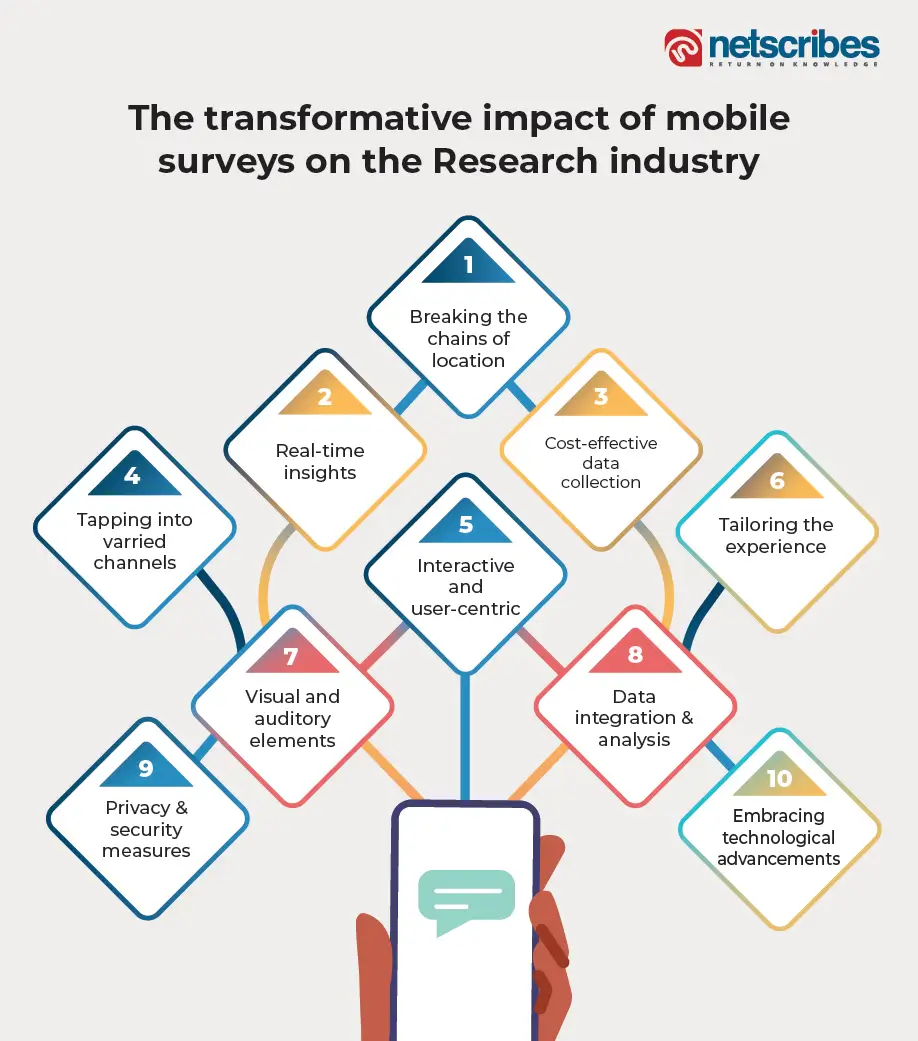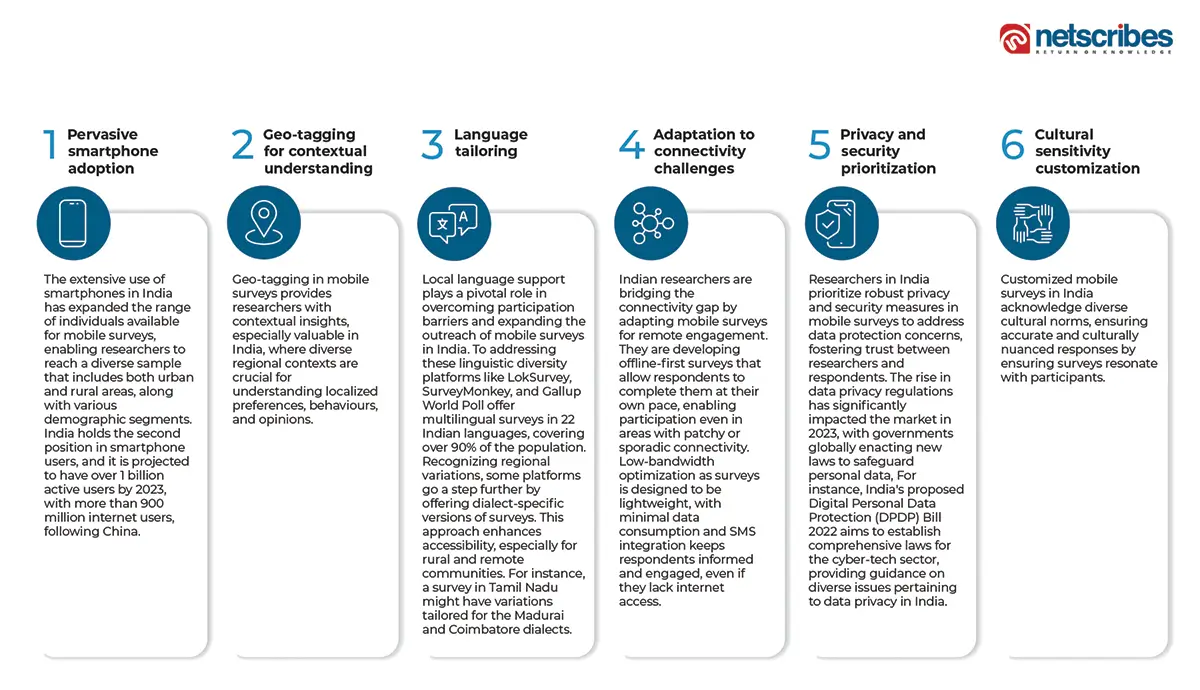Highlights
- Revolutionizing data collection, mobile surveys provide real-time insights, connecting researchers with diverse participants for an adaptive user experience.
- Mobile-first surveys, pivotal for businesses by 2024, offer real-time precision, diverse reach, and cost-effective methodologies, disrupting traditional market research.
- Heightened response rates, rapid analysis, and customization make mobile surveys a key tool for addressing challenges in traditional market research.
- From consumer feedback to political sentiment analysis, mobile surveys enhance research processes, leveraging technology for user-centric approaches.
Market researchers now have unprecedented access to consumers. This allows them to gather real-time, on-the-go feedback about products, services, and events rather than waiting for them later. Mobile surveys are increasingly revolutionizing data collection in the research industry, connecting researchers with diverse participants and providing real-time insights. This shift in user engagement has led to adaptive survey designs, cost-effective methodologies, and an immersive user experience. The switch from static surveys to dynamic mobile-driven methodologies is not just a technological evolution. It’s a narrative of how research is evolving to meet digital demands.
Embracing mobile-first innovation in interactive surveys
Mobile-first innovation in interactive surveys is gaining prominence due to widespread usage. These smart surveys provide real-time insights into consumer trends, disrupting traditional market research. By 2024, mobile-first intelligent survey techniques will be pivotal for businesses.

With more than half of internet traffic originating from mobile devices and a substantial 90% from mobile apps, the significance of mobile applications is undeniable. Many crucial tools for mobile surveys allow to capture real-time feedback from users enhancing product experience. These surveys measure customer sentiments across various aspects of the product. The right questions, categorized by user experience, design, usability, support, pricing, and features, can help reduce churn and improve app success.
Mobile surveys provide diverse audience reach, swift results, real-time precision, conciseness, and enhanced data integration. They reach a broad demographic, provide instantaneous insights, and enable users to share information with technology. The enumerated benefits of mobile surveys address two pivotal objectives in market research: enhancing both sample and data quality. By prioritizing these factors, brands can optimize their research processes, focusing on user convenience and leveraging mobile technology.
Instances of mobile surveys in practice
- Utilizing mobile surveys for market insights:
Brands can employ mobile surveys to gather consumer feedback on products, services, and advertising campaigns. This can provide valuable insights that inform and refine their marketing strategies. - Harnessing mobile surveys for public opinion analysis:
Political campaigns and government agencies can leverage mobile surveys to gauge public sentiment. It can be done on a range of issues and policies, facilitating more informed decision-making processes. - Incorporating mobile surveys into academic inquiry:
Researchers across various disciplines, from social sciences to healthcare, increasingly integrate mobile surveys into their studies. This method enhances the reach and accuracy of data collection, contributing to the advancement of academic research.
Beyond pen and paper: Assessing the impact of mobile surveys on market research
Mobile surveys provide businesses with numerous advantages, such as heightened response rates, cost-effectiveness, enhanced result accuracy, rapid analysis, participant-friendly interfaces, heightened researcher productivity, and customizable survey designs.
- The efficiency of online surveys is evident as they take two-thirds less time to complete than traditional methods, with over half of responses received within the initial few days of a project.
- Automation reduces research costs, while features like Skip logic enable tailored participant experiences.
- Researchers save time and boost productivity by seamlessly transferring data to specialized software.
- With customizable styles and dynamic question orders based on previous responses, mobile surveys emerge as a cost-effective and efficient means of engaging target audiences.

Mobile surveys offer researchers location independence, capturing real-time insights as respondents carry smartphones everywhere. This immediacy provides a dynamic understanding of sentiments, behaviors, and preferences, eliminating paper and manual data entry. Seamless integration with various data sources enriches datasets, while user-centric design reduces dropout rates and adaptive survey features ensure personalized engagement for higher response quality. Multimedia integration enhances survey experiences. Mobile survey platforms streamline the transition from data collection to analysis, ensuring an efficient workflow. Advanced privacy measures foster participant trust. Embracing mobile methodologies reflects a forward-looking mindset, positioning researchers to adapt to evolving innovations in the research landscape.
The Indian scenario
In the realm of Indian research, the surge of mobile surveys has brought about a substantial impact, providing researchers with fresh avenues to gather data, involve participants, and elevate the entire research process. The enhanced user engagement and language customization have boosted response rates, reflecting India’s diverse demographics. Mobile surveys have become a catalyst for inclusivity, providing researchers with a comprehensive view of participant insights. The following highlights key findings and observations on how researchers in India are utilizing mobile surveys to augment their research results:

Navigating the future – The latest trends in mobile surveys
Mobile ethnography, as a trend, integrates real-life contextual insights into surveys, particularly in fields like retail research, where participants’ experiences are captured through photos and videos. This approach not only saves researchers time and resources but also enables virtual observation of participants’ daily activities. In the realm of medical research, this methodology extends to observing a patient’s journey without the necessity of an on-site video team, ensuring non-intrusive data collection.
The potential applications of Artificial Intelligence (AI) in mobile research are limitless. From targeted advertising to recommendation engines and the automation of datasets, AI offers promising possibilities to expedite market research. Unlike traditional online surveys, AI enables surveys to be conducted via voice, adding a human touch. Brands are adopting voice survey tools, allowing users to provide hands-free feedback, a qualitative approach that delves into the emotions behind words. This innovative development captures the genuine sentiment of participants, providing valuable insights for researchers.
Related reading: 5 Emerging AI applications in market research
Geo-fencing technology on smartphones allows for in-the-moment research by detecting participants entering or leaving specific locations. It aids in identifying the intended respondent and verifying response authenticity. An emerging trend, negative fencing, sends surveys post-experience, encouraging more in-depth and high-quality responses. Combining both approaches allows researchers to compare initial and enduring impressions, gaining insights into customers’ intentions and potential reasons for variations.
The emergence of seamless survey submissions including QR code and SMS-based surveys, have become prominent. This approach, emphasizing convenience for respondents, also provides businesses with a swift and efficient means of collecting insights.
The dynamic realm of mobile surveys
The landscape of mobile surveys is constantly evolving, and it’s imperative to stay abreast of the latest trends and statistics. According to Statista, as of 2023, the global count of smartphone users stands at 4.6 billion, encompassing 57% of the world’s population—a clear indication that a substantial portion of survey participants engage through mobile devices. The projected trend indicates a consistent rise in the worldwide smartphone user count from 2024 to 2028, amounting to a cumulative increase of 496.7 million users, marking a growth rate of 10.7%.
However, with distinct advantages such as heightened convenience and accessibility, these surveys face unique challenges. Generally this is due to the confined screen dimensions, necessitating the creation of surveys with clear, concise questions and streamlined answer options.
Mobile users’ attention span is another challenge, as they often multitask and are distracted. However, mobile surveys can be effective when designed correctly. They can easily harness a 10% completion rate surpassing desktop surveys, higher response rates, and lower costs.
Obstacles to studies conducted through smartphones encompass challenges related to smartphone accessibility, utilizing devices for data collection tasks, and obtaining consent for data sharing. These elements may impede the involvement of sample members in studies involving mobile app and sensor data collection.
Wrapping it up
The mobile survey offers speed, cost-effectiveness, broader reach, real-time data, and contextual insights. It allows businesses to collect data efficiently and make informed decisions, shaping the future of market research and consumer insights.
As mobile surveys progress in their development, these recent trends emphasize a dedication to innovation, prioritizing user-centric approaches and a more profound comprehension of respondent experiences. Whether harnessing emerging technologies or fortifying privacy and security protocols, the trajectory of research is dynamic, engaging, and progressively mirrors the diverse and interconnected world we inhabit.
To know how Netscribes primary research can help your business use mobile surveys to gain real insights into your next research need, contact us today.
Based on insights by Priyanka Jain, Senior Research Analyst, Market Research
FAQs
Mobile surveys provide real-time, on-the-go feedback, connecting researchers with diverse participants and offering adaptive survey designs for an immersive user experience.
Mobile surveys offer heightened response rates, cost-effectiveness, rapid analysis, participant-friendly interfaces, and customizable designs, enhancing the efficiency of data collection and analysis.
Mobile surveys offer speed, cost-effectiveness, broader reach, real-time data, and contextual insights, addressing challenges like confined screen dimensions and shorter attention spans.:
Trends include mobile ethnography for contextual insights, AI applications for targeted advertising, geo-fencing technology for in-the-moment research, and innovative survey submission methods like QR codes and SMS-based surveys.
Mobile surveys reflect a dedication to innovation, user-centric approaches, and an evolving comprehension of respondent experiences, ensuring a diverse and interconnected research world.






